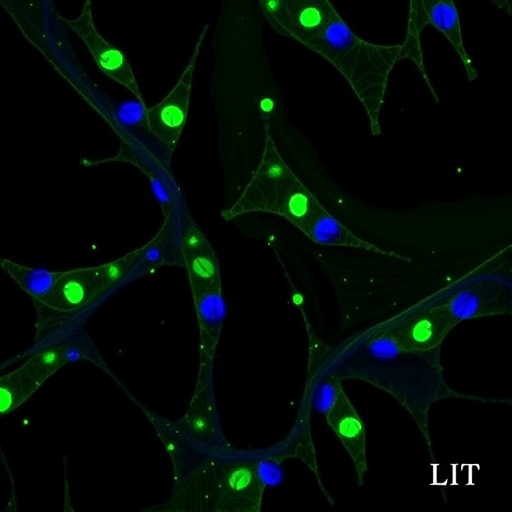In the relentless pursuit of more effective and targeted cancer therapies, the discovery and development of novel drug delivery systems remain paramount. A recently published study in BMC Cancer introduces a groundbreaking compound, VAF, which represents a novel folate-α-tocopherol conjugate designed to combat lung cancer cells with enhanced precision and reduced toxicity. This innovative approach seeks to revolutionize existing chemotherapeutic methods by leveraging the natural targeting abilities of folate receptors while harnessing the potent antioxidant properties of α-tocopherol.
Cancer treatment has long been plagued by the challenge of selectively targeting malignant cells without causing severe adverse effects to healthy tissues. Traditional chemotherapy, despite its widespread use, often results in significant systemic toxicity and a narrow therapeutic index. The research on VAF aims to overcome these obstacles by integrating folic acid, known for its high affinity toward folate receptors overexpressed in many cancer cell types, with α-tocopherol, a biologically active form of vitamin E, known for its cell-protective antioxidant activities.
The synthesis of VAF involved the conjugation of folic acid and α-tocopherol through the formation of a peptide bond. This strategic linkage generated an amphiphilic molecule capable of self-assembly in aqueous environments, an essential feature that facilitates its stability and bioavailability. The amphiphilic nature allows VAF to form nanostructures able to navigate the bloodstream effectively and selectively bind to folate receptors highly expressed on the surface of lung cancer cells, notably the A549 cell line.
To meticulously characterize the molecular structure of VAF, the researchers employed robust analytical techniques, including Fourier-transform infrared spectroscopy (FTIR) and nuclear magnetic resonance (NMR) spectroscopy. These methods confirmed the successful conjugation and preserved functional groups essential for receptor targeting and cellular uptake. The mild synthesis conditions not only preserved the integrity of both folic acid and α-tocopherol but also reduced the risk of degradation or formation of unwanted by-products, a significant advantage for subsequent therapeutic applications.
The heart of the study lies in the in vitro assessment of VAF’s anticancer efficacy using A549 lung cancer cells, a widely recognized model for human non-small cell lung cancer research. These cells are characterized by an abundance of folate receptors, making them an ideal candidate to evaluate the targeted delivery potential of VAF. The experiments demonstrated that VAF exhibited superior cytotoxicity against the A549 cells compared to non-targeted controls, supporting the concept that the conjugate effectively exploits the folate receptor-mediated endocytosis pathway.
Beyond targeting efficacy, the study also investigated the compound’s selectivity and toxicity profile. Using Wi-38 cells, a human lung fibroblast cell line representing non-cancerous cells, researchers assessed the biocompatibility of VAF. Confocal laser scanning microscopy (CLSM) analyses revealed that VAF caused minimal cytotoxic effects on these healthy cells, highlighting its selective action against cancerous tissue. This selectivity is crucial, as it points to the potential for fewer side effects and improved patient outcomes in clinical scenarios.
One of the most groundbreaking revelations of this research is the dual functional role of VAF. While folate facilitates active targeting, α-tocopherol contributes antioxidant properties that may protect normal cells from oxidative damage induced by chemotherapy. This interplay positions VAF not merely as a cytotoxic agent but as a multifunctional therapeutic that balances anticancer action with cytoprotection. The implications of this duality could significantly refine the therapeutic indices of chemotherapeutic regimens.
The self-assembling nature of VAF in physiological conditions could also offer significant benefits in drug delivery science. Nanoassemblies promote enhanced permeability and retention effect within tumors, allowing for passive targeting in addition to active receptor-mediated uptake. This multimodal targeting approach might increase the accumulation of VAF within the tumor microenvironment, maximizing its therapeutic impact while sparing normal tissues.
The authors emphasize the importance of VAF’s synthesis under mild conditions, which not only preserves bioactive components but also potentially simplifies scalable production. This is a vital consideration for the development of any new pharmacological agent, as manufacturing feasibility often dictates translational success from bench to bedside.
Looking forward, the promising results of this in vitro study pave the way for in vivo evaluations. Animal model studies will be essential to confirm the biodistribution, pharmacokinetics, and long-term safety profile of VAF. Furthermore, synergistic effects with existing chemotherapeutic agents could be explored to determine additive or multiplicative benefits in lung cancer treatment regimens.
Lung cancer remains one of the deadliest malignancies worldwide, largely due to late diagnosis and limited effective treatment options. The advent of VAF’s targeted therapy mechanism could signal a paradigm shift in clinical oncology. By exploiting specific molecular markers unique to cancer cells, such as folate receptors, it holds the promise to circumvent common obstacles associated with chemotherapy, such as drug resistance and toxic side effects.
Moreover, the concept of employing vitamin derivatives like α-tocopherol in conjugation with targeting ligands introduces a versatile platform for drug design. This approach could be extended to include other vitamins or bioactive molecules, broadening the potential applications beyond lung cancer to other folate receptor-positive malignancies, including ovarian and breast cancers.
The findings presented in this study underscore the critical role of interdisciplinary collaboration between chemistry, molecular biology, and oncology. Such integration fosters innovation in creating compounds like VAF that meld precise molecular targeting with therapeutic efficacy, thereby pushing the frontiers of personalized medicine.
In summary, the research on VAF embodies a transformative leap toward more sophisticated and safer anticancer therapeutics. It showcases how smart molecular engineering can reconcile the dual demands of potency and selectivity, a long-sought goal in the fight against cancer.
As the research community continues to explore and refine VAF, it stands as a testament to the potential of harnessing natural biological pathways for enhanced drug delivery and treatment outcomes. The blending of folate receptor targeting with antioxidant vitamin conjugation may well chart a new course in effective lung cancer management.
For patients and clinicians alike, innovations such as VAF bring hope—a vision of cancer therapy that is not only more effective but also kinder to the body it aims to heal.
Subject of Research: Evaluation of a novel folate-α-tocopherol conjugate (VAF) for targeted anticancer activity against lung cancer cells.
Article Title: Evaluating the anticancer properties of VAF: a novel folate-α-tocopherol conjugate against lung cancer cells.
Article References:
Abdel-Hafez, S.H., Alexeree, S.M.I. Evaluating the anticancer properties of VAF: a novel folate-α-tocopherol conjugate against lung cancer cells. BMC Cancer 25, 1423 (2025). https://doi.org/10.1186/s12885-025-14954-8
Image Credits: Scienmag.com
DOI: https://doi.org/10.1186/s12885-025-14954-8




